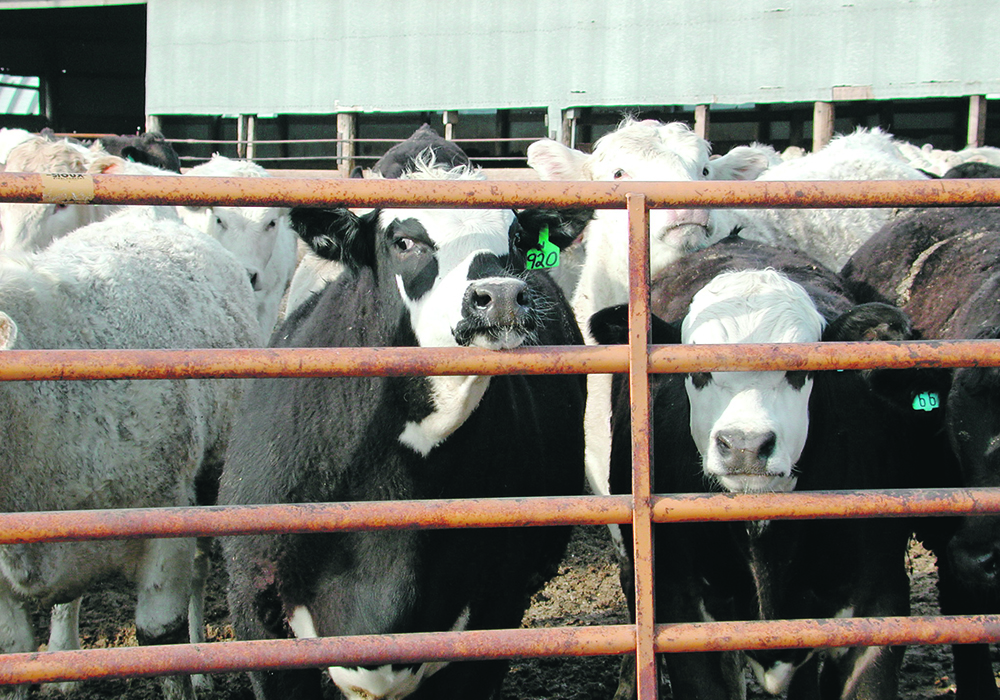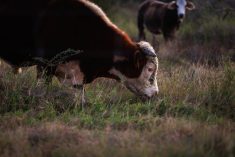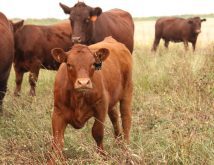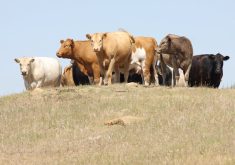Cows and calves can both benefit from the practice in a year when feed sources are limited due to poor growing conditions
Early weaning can be a viable option when pasture and feed supplies are low due to drought, academics and specialists say.
Dr. Bart Lardner and Dr. Greg Penner, both with the University of Saskatchewan, say early weaning can reduce cows’ nutrient requirements. If calves can transition through weaning with little stress and effect on appetite, cows and calves can both benefit in a year when feed sources are limited.
“(Calves) must be fed quite differently than cows. Milk is very energy-dense and we need to provide something with similar nutrient levels,” says Penner.
Read Also

The Western Producer Livestock Report – November 6, 2025
Western Producer Livestock Report for November 6, 2025. See U.S. & Canadian hog prices, Canadian bison & lamb market data and sales insights.
Choice of feed will depend on age of the calves at weaning. Early weaning is a broad term and could mean 45 days or 120 days old, and there’s a big difference in what those calves need.
“The feeding and management of the younger ones is more challenging, making sure they are eating enough of a very high-quality calf starter. There are some risks associated with younger calves, like coccidiosis or digestive upsets,” Penner says.
Dwayne Summach, a livestock and feed specialist with Saskatchewan Agriculture, says early weaning for most people means about four to five months of age, since three-month-old calves need more care than most beef producers want to provide.
“We could wean calves at 20 days of age, but it’s more practical to wean a four-month-old calf. Even at that age, calves will be small, but they’ve been with mom long enough to have a good start,” says Summach.
By that age calves have been eating grass, the rumen is developing and they have adequate rumen microbes to digest forage.
“They still need concentrated, high-quality palatable feed if they no longer have milk. The feed must be higher quality than most people realize,” he says.
“Concentrates must be palatable, and if we can avoid lots of starch, we avoid some of the common digestive upsets. This is where dried distillers grains are ideal because calves like it. Corn distillers grain is very palatable and sweet tasting,” says Summach.
He advises getting calves used to eating the feed before weaning because they may be reluctant to try foods they’ve never eaten before.
“One drawback to distillers grain is that it may be too high in protein. It needs to be a balanced diet. We usually want a concentrated feed supplement that’s about 16 to 18 percent protein and nutrient dense.
“If we’re starting with 200-pound calves on May 15 or June 1 and want them to be 650 lb. by late October, they must gain more than two lb. per day. They need high quality feed, usually some combination of proteins and grain, and often talking about creep feeders and free-choice access. We need to include some fibre, so a creep feed often includes some alfalfa pellets, beet pulp pellets or some other non-starch carbohydrates.”
Weaned calves put directly on pasture may just coast along and not gain. They need feed suited for growth and performance.
“We need to feed them better, which means buying more supplement (and) more cash cost,” Summach acknowledged. “It should, however, result in improvement in overall profitability because calves are more efficient converters of concentrates when they are young. Their feed-to-gain ratio is usually better, the younger they are.”
Alexis DeCorby, a livestock and feed specialist with Saskatchewan Agriculture, says when forage availability is poor, early weaning can take pressure off cows so they regain weight before winter.
“A fatter cow is easier to feed through winter than a thin cow that needs to put weight back on. If cows come off pasture in poor condition and we must supplement them right away with grain, we lose the opportunity to utilize poor-quality feeds when their nutritional requirements are low,” she says.
“There are benefits of really early weaning. If a cow is no longer lactating, there is better chance for her to rebreed and have a calf next year. If we wean early, however, we must make sure those babies are used to eating something first.
“Sometimes when weaning early you might catch a good market ahead of the fall glut. Other times it may be better to background those calves longer. It depends on your operation and the markets. If you can hold them and grow them, you have more control on when you sell them, and wait for the price to get better.”
If the calf weighs 300 to 400 lb., what is the target for weight at sale time?
“What is your expected average daily gain?” asks Lardner. “Is it 1.5 to two lb. per day? Expected feed intake for those calves would be nine to 11 lb. per day. They need some forage, with enough energy and protein in the diet.
“We’ve looked at all kinds of different fibre sources for cows, and options might include salvage crops. But with calves you must make sure they can handle the feed and keep gaining and growing. Basically, you are just backgrounding them early.”
Lardner advises producers to figure out how much daily gain is needed for calves to reach the desired target.
“Have an objective, and make sure you have a market. You might have an arrangement with a local feed yard or someone who is finishing calves, or sell through an auction market,” says Lardner.
If the calves are already weaned and backgrounded, they are more saleable.
Due to drought, many forages don’t have optimum vitamin or mineral levels so supplements may be needed for rebreeding success and for calves that perform well.
“The open rate will probably be higher this year if we don’t consider weaning early or supplementation. Consult with your vet if you plan on early weaning. Your vet may recommend a different vaccination program for those young calves, to help with some of these issues,” says DeCorby.















